
Horseshoe crabs are arthropods of the family Limulidae and are the only surviving xiphosurans. Despite their name, they are not true crabs or even crustaceans. Rather, they are chelicerates. This makes them more closely related to arachnids like spiders, ticks, and scorpions. The body of a horseshoe crab is divided into three main parts: the cephalothorax, abdomen, and telson. The largest of these, the cephalothorax, houses most of the animal's eyes, limbs, and internal organs. It is also where the animal gets its name, as its shape somewhat resembles that of a horseshoe. Horseshoe crabs have changed little in appearance since they first evolved in the Triassic, earning them the title of "living fossil".
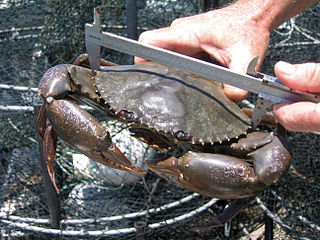
Scylla serrata is an ecologically important species of crab found in the estuaries and mangroves of Africa, Australia, and Asia. In their most common forms, their shell colours vary from a deep, mottled green to very dark brown.

Mangrove forests, also called mangrove swamps, mangrove thickets or mangals, are productive wetlands that occur in coastal intertidal zones. Mangrove forests grow mainly at tropical and subtropical latitudes because mangrove trees cannot withstand freezing temperatures. There are about 80 different species of mangroves, all of which grow in areas with low-oxygen soil, where slow-moving waters allow fine sediments to accumulate.

The Ocypodidae are a family of semiterrestrial crabs that includes the ghost crabs and fiddler crabs. They are found on tropical and temperate shorelines around the world.

The mangrove horseshoe crab, also known as the round-tailed horseshoe crab, is a species of horseshoe crab, a chelicerate arthropod found in tropical marine and brackish waters of India, Bangladesh, and Southeast Asia. It may also occur in Sri Lanka, Myanmar and the Philippines, but confirmed records are lacking. It is the only species in the genus Carcinoscorpius.
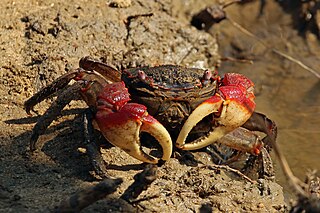
The Sesarmidae are a family of crabs, previously included in the Grapsidae by many authors. Several species, namely in Geosesarma, Metopaulias, and Sesarma, are true terrestrial crabs. They do not need to return to the sea even for breeding.

Chiromantes haematocheir, commonly known as red-clawed crab, is a species of mudflat crab in the family Sesarmidae. It is endemic to East Asia and is quite distinct from the other species placed in the genus Chiromantes. The genus may be restricted to this one species.

Parasesarma pictum is a mudflat crab, belonging to the Sesarmidae family, which is endemic to East Asia. This crab typically inhabits mangrove swamps, preferring the upper intertidal region of estuaries, and living in small crevices and abandoned holes made by other species. It eats leaf litter and other vegetation. The breeding season of P. pictum is between May and September.

Helice tridens is a species of crab which lives on mudflats around the coasts of Japan and the Korean Peninsula.

Ocypode ceratophthalmus, the horned ghost crab or horn-eyed ghost crab, is a species of ghost crab. It lives in the Indo-Pacific region ; from the coast of East Africa to the Philippines and from Japan to the Great Barrier Reef. They also occur in the Pacific Islands to as far east as Polynesia and Clipperton Island. As their common name implies, O. ceratophthalmus possess eyestalks extending beyond the eyes into long points, which are longer in adults, and shorter in juveniles. The crabs have a box-shaped body, 6–8 centimetres (2.4–3.1 in) across the carapace, with a darker markings towards the rear in the shape of an H. The outer edges of the eye-sheaths are also sharp and broadly triangular and distinctly pointing sideways in larger individuals. O. ceratophthalmus can run at speeds of up to 2.1 metres per second (6.9 ft/s).

Aratus pisonii, commonly known as the mangrove tree crab, is a species of crab which lives in mangrove trees in tropical and subtropical parts of the Americas, from Florida to Brazil on the Atlantic coast. A.pacificus occurs from Nicaragua to Peru on the Pacific coast. A. pisoni feeds mostly on the leaves of the mangroves, but is an omnivore, and prefers animal matter when possible. A. pisonii and A. pacificus are the two species in the genus Aratus. The specific epithet pisonii commemorates the Dutch naturalist Willem Piso who travelled in Brazil in 1638 with Georg Marggraf.

Heloecius cordiformis is a species of semiterrestrial crab found in mangrove swamps and mudflats along the east coast of Australia. Adults are around 25 mm (1 in) wide, with males being larger and having larger and more conspicuously coloured claws. The males wave their claws to communicate with other crabs, giving them their common name of semaphore crab. They can breathe both in air and under water, and feed at low tide on detritus in the sediment. H. cordiformis is the only species in the genus Heloecius and the family Heloeciidae.
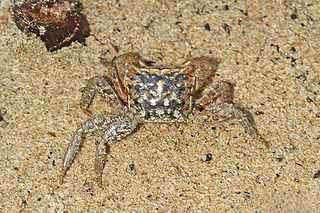
Metopograpsus messor is a species of grapsid crab that lives in mangroves from East Africa to Fiji.

Tumidodromia dormia, the sleepy sponge crab or common sponge crab, is the largest species of sponge crab and the only species in the genus Tumidodromia. It grows to a carapace width of 20 cm (8 in) and lives in shallow waters across the Indo-Pacific region.

Geograpsus severnsi is an extinct species of land crab from Hawaii. It died out shortly after humans colonized the Hawaiian Islands. It is the first known documented crab to become extinct after the ice age.
Chiromantes eulimene is a species of crab found in the mangrove swamps of south-eastern Africa.
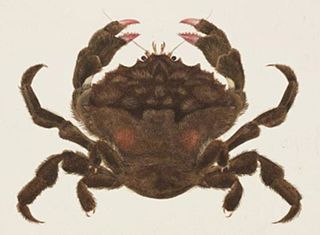
Lauridromia dehaani is a species of crab in the family Dromiidae. It is native to the Red Sea and the western Indo-Pacific. It often carries a piece of sponge on its carapace by way of camouflage, and if unable to find a suitable piece of sponge, carries an empty bivalve shell, a sprig of seaweed or a piece of debris instead.
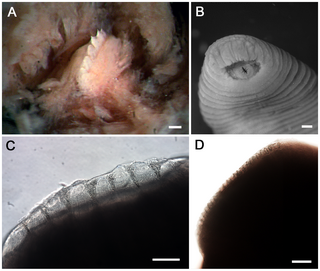
Praobdellidae is a family of hematophagous leeches which live on the mucous membranes of mammals and sometimes invertebrates. These are internal parasites that enter the body through natural orifices, and cause hirudiniases.

Parasesarma messa, commonly known as the maroon mangrove crab, is a species of burrowing crab found in Queensland, Australia. It lives in mangroves in estuaries and sheltered bays. It was originally described as Sesarma messa, but was placed in the genus Parasesarma in 2017. Perisesarma messa is also a synonym.

Sesarmops is a genus of crabs in the family Sesarmidae. Its members are distributed through the Indo–West-Pacific oceanic region. They live in freshwater forest streams near the coast, and in mangroves.



















